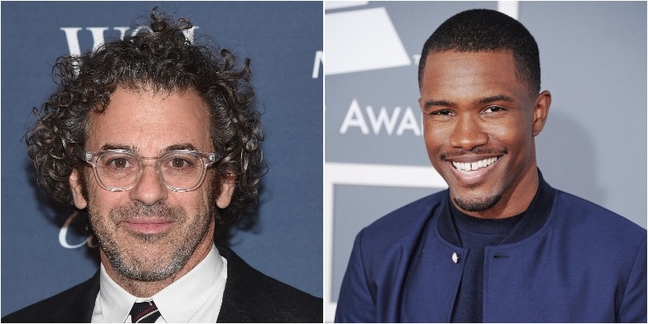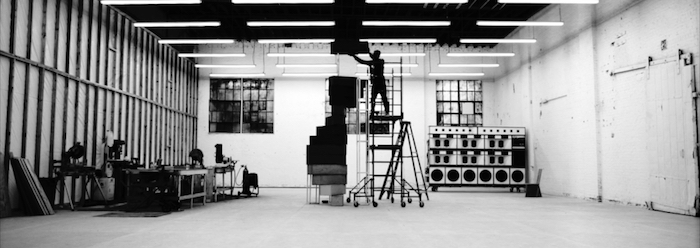
Tom Sachs Explains Frank Ocean’s Endless “Stairway to Heaven”

On August 1, Frank Ocean’s website added a mysterious, Apple Music-hosted video live stream. In the background at one point was a large boombox—part of an installation by acclaimed artist Tom Sachs. In the wee hours of August 19, Ocean released his new visual album Endless, and the credits gave “special thanks” to Sachs, among others. On August 20, Ocean released his new album Blond, called Blonde on Apple Music. At the same time, Ocean also released his Boys Don’t Cry magazine, which again features Sachs among its contributors. Today, Pitchfork chatted with Sachs over the phone about Endless (he declined to detail his role on the magazine until seeing a final copy himself).
Pitchfork: How did you get to know Frank?
Tom Sachs: He called me on the phone and we started a dialog about a lot of things that we’re both interested in. We’ve just been talking about different things. So we started on the phone and then we met in person in New York and in L.A. a few times. And we’ve dicked around with a few things in the studio. In my studio, and I worked a little on the zine, which I haven’t seen yet. I went to go buy it, but I guess it’s not for sale. I went to the place and they said that they gave away 1,500 copies yesterday.
What else can you tell me?
I know there was a huge wait on this for all this to come out. I think it’s testament to the reality that things made by hand take time. We’re living in an age of non-handmade things. The iPhone is the best-made thing there is, but there’s no evidence of a human being involved with it. Frank’s music, which is very personal and literally has his voice, in the same way that all musicians have their voice, it simply takes time. And when you see the video, you see him building a stairway to heaven in real time. The 40-minute version is edited, but there’s something like a 140-hour version. That’s the whole thing. That exists, that’s the art piece.
The thing that we’re all seeing is the short, is the edited version. This version where there are three of them is kind of a compressed experience, where you see three Frank Oceans making the same thing. It’s not unlike the song on Blond called “Skyline To.” You hear what sound like a couple of Frank Oceans singing over each other. I think that’s his voice—I know a bunch of other people sing on it—but you hear him unapologetically laying two vocal tracks over each other, the chorus and the refrain. And they overlap in the same way you’ve got a couple of Frank Oceans building the staircase and a couple of times in the video they cross through each other, impossibly, without colliding.
If things that are made by hand take time, this stands as something that we all can learn from and take an opportunity in whatever our work is and our lives to do things by hand and do things that speak of the individual. Our personalities and characters are being homogenized through the greatness of the computer. But there is an opportunity every once in a while to leave your fingerprint on something.
Let me finish writing that down.
I’m not speaking out against Auto-Tune. This is just another opportunity.

Well, that’s a question I had for you, was what is the symbolism of this staircase?
When he’s building, you see him literally building every component of this complex structure. Each stair is a plywood box. And you see the plywood end grain. You see each stair being stacked on top of each other onto a central steel column that’s welded and bolted to the ground. So there’s a transparency to the building that is the same as the transparency in the music. The spiral staircase is also an endless column—a reference to Romanian sculptor Constantin Brancusi’s work.
Frank’s music is simultaneously complex and simple. But no matter how you slice it you can hear what’s going on. And there are sounds that are not musical sounds that are used musically to convey a mood. And all of that stuff is transparent and helps communicate how the music was made.
And also, that is one of the foundations of hip-hop and soul music—the transparency. Versus classical music where the orchestra of many, many people work together to create one sound, or with Phil Spector’s Wall of Sound. There’s always been an attempt to make something where you can understand without thinking, to feel. There’s always been this transparency in hip-hop for lots of reasons. Even if you go back to the vinyl record, you can hear the flaws and the skips and the errors, and those are kind of the foundation of the sample.
How could those of us at home build our own Frank Ocean stairway to heaven?
You could build your own if you just watch the video. I would encourage you [laughs] if you were to make your own own Frank Ocean staircase to heaven to watch Love Letter to Plywood and How to Sweep— which are the movies that Frank watched that I made—which are the building code of the studio. You’ll see some connections there.
That raises the question: Were there any other stylistic references, films, or works of art that you guys talked about, that influenced the visual album?
Oh my God, I don’t even know where to begin. Let me make it clear: I can’t say I take credit for anything there. He did a great job, and he’s a talented man, so he can do anything. But Love Letter to Plywood is a pretty good primer for how to do shit in plywood. Again, the idea of conveying the transparency of building. When we build in the studio we always paint the plywood first and then cut it so you can see the end grain. That’s an important foundation. That’s something that I’ve taken from the music that I’ve loved that has been transparent in the way it tells a story.
Is it Blonde with an “e”? Or without an “e”? What’s the symbolism there?
[laughs] I don’t know. And also an album of this complexity takes a couple of days to sink in. If you would ask me what I thought of the new record, I would say I just need a little more time, but it’s great. This is the kind of record that you need to listen to with headphones.













Recent Comments